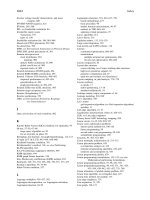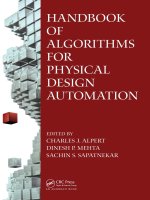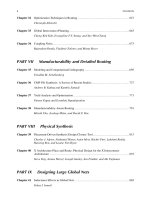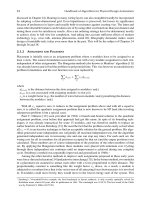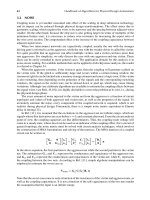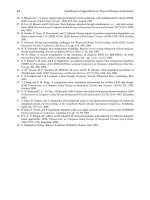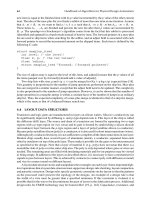- Trang chủ >>
- Khoa Học Tự Nhiên >>
- Vật lý
Handbook of algorithms for physical design automation part 104 ppsx
Bạn đang xem bản rút gọn của tài liệu. Xem và tải ngay bản đầy đủ của tài liệu tại đây (383.08 KB, 14 trang )
Alpert/Handbook of Algorithms for Physical Design Automation AU7242_C048 Finals Page 1012 9-10-2008 #12
1012 Index
Inverter v oltage transfer characteristic, and noise
margins, 680
INVERT-NAND sequence, 821
IP block, 265–268
IRL, see Irreducible re alization list
Irreducible empty rooms
T-junctions, 197
types of, 198
Irreducible realization list, 180, 963–964
Island-style FPGA placement, 967–968
Iso-dense bias, 706
ISPD, see International Symposium on Physical Design
ISPD 2005, global placements of, 301
Itanium microprocessor
clock distribution, 910
topology, 908
deskew buffer architecture of, 909
global core H-tree of, 908
regional clocks of, 909
Iterated dominance (IDOM) graph, 494
Iterated KMB (IKMB) construction, 495
Iterated 1-Steiner (I1S) heuristic, 490–492
empirical performance of, 493–494
generalization of, 494
graph generalization of, 494–495
Iterated Zelikovsky (IZEL) heuristic, 495
Iteration target acceptance rate, 316
Iterati ve floorplanning, 153
Iterative partitioning, 339
ITRS, see International Technology Roadmap
for Semiconductors
J
Jitter , arriva l time of clock transition, 882
K
Karush–Kuhn–Tucker (KKT) condition, for optimality, 95
kd tree, 57–59, 67–68
range query algorithm on, 59
for set of points on plane, 58
Kernighan–Lin heuristic, for graph b ipartitioning, 114–115
K-input LUT (K-LUT), 943–944, 958–960
Kirchhoff boundary condition, 701
Krishnamurthy’s method, 116; see also Partitioning
KLFM algorithm, 841
K-LUT technology mapping in O(KVE), 959
KMB algorithm, 494
KMB graph Steiner h euristic, 518
Kou, Markowsky, and Berman (KMB) method, 494
Kraftwerk, 349, 351–352, 365–366, 370–371, 373, 437
Kruskal’s algorithm, 59, 79–80
Kuhn–Tucker condition, 537
L
Lagrange multiplier, 436–437, 592
Lagrangian decomposition, see Lagrangian relaxation
Lagrangian function, 94–95
Lagrangian relaxation, 591, 616–617, 799
based methodology, 475
basic procedure, 96
duality function maximization, 96–97
method, in TDP, 440–441
updating of dual parameters, 97
Lam’s algorithm, 314
Lam’s theory, 315
Laplacian matrix, 113, 118–120
Large scale integration, 139
Last-in-first-out (LIFO) scheme, 116
Latency
constrained optimization, 666–667
minimization
multiple-terminal net optimization, 666
two-pin net optimization, 664–666
Layout compaction, 20
Layout data structure
corner stitching (see Corner stitching data structure)
high level operations support, 62
parasitics computation and, 63
quad tree and variants (see Quad trees)
Layout sampling, in yield analysis, 778–779
Layout synthesis
as masks, 17
netlist partitioning, 15–16
standard-cell/polycell, 18
Leakage current, major components of, 46
Leakage modeling, 918–920
Lee’s algorithm, 476
Lee’s router
grid expansion algorithm (see Grid expansion algorithm)
speedup, 11
Left-edge algorithm, 15, 21
Legalization and placement, limits of, 420–421
LER, see Line edge roughness
Library-based ASIC technology mapping, 959
Linear circuit, 34–35, 678, 920, 927
Linear conic optimization problems
interior point methods for, 100–101
linear programming, 99
second-order cone programming, 99–100
semidefinite programming, 100
Linearity, 93, 703, 723, 800
Linear netlength, minimization of, 331–332
Linear placement problem, 418
cost function, analysis of, 419
dynamic programming algorithm, 419–420
notations and assumptions in, 419
Linear programming duality, 629
Linear programming formulations, 122–123; see also
Mathematical partitioning formulations
Linear programming problem, 93, 98, 252, 932
Linear program/programming, 89, 105, 331, 341, 424,
435–436, 438–442, 451–452, 751, 760
Linear relaxation, of global routing problem, 627
Linear time algorithm, in rectangular dual, 145
Linear-time method, for module, 173
Line edge roughness, 774
Line expansion, 11, 479
Line graph, 120–121
Alpert/Handbook of Algorithms for Physical Design Automation AU7242_C048 Finals Page 1013 9-10-2008 #13
Index 1013
Line-search algorithms, 476
Line search directed placement, 365–366, 386, 391, 393
Liquid routing, 840, 848
Lithographic modeling
contour-based EPE, 715–717
extraction and SPICE modeling, 731
mask manufacturing flow, 715
modeling fundamentals, 699–700
computation by superposition, 704–705
linearity, 703–704
Maxwell’s equations, 700–701
propagation, 701–703
RET flow and computational lithography, 713–715
RET tools, 705–706
OAI, 710–711
OPC, 706–707
polarization, 712–713
PSM, 707–710
RET combinations, 711–712
Lithographic processing, 697–699
Lithographic simulation, of single layer of IC layout, 705
Lithography-aware maze routing algorithm, 799
Lithography-aware routing, for printability, 798–800
Local area constrained (LAC), 669
Local clock buffer (LCB), 830, 909
latches cluster, 831
Local improv e ment
cell mirroring and pin assignment, 414–415
linear placement and fixed orderings, 418
cost function, analysis of, 419
dynamic programming algorithm, 419–420
notations and assumptions in, 419
optimal interleaving, 417–418
reordering of cells, 415–417
Local oxidation of silicon (LOCOS), 745
Location-based clustering method, 388–389; see also
Multiscale optimization, in placement
Logic array blocks (LABs), 945
Logic b lock architectures
lookup-tables (LUTs), 944
carry chains, 946–947
clusters, 945–946
non-LUT-based logic blocks, 947
Logic circuits
components of, 55
mathematical structure representing, 56
and netlist, 56
Lognormal delay, 38–39
Longest common subsequence (LCS), 215
Lookup tables, 944, 947, 953, 958–960, 970–972
Loss-contracting algorithm (LCA), 495, 503
Low-cost low-radius tradeoff hybrid tree, 511
Lower conve x hull, 573
Low power FPGA placement and routing methods, 975
LP, see Linear program/programming
LSD, see Line search directed placement
LSD placers, 365–366
L-shaped routes, 604
LSI, see Lar ge scale integration
LUTs, see Lookup tables
M
Macrocell layout, 18
Macrocell placement problems, 319
Manhattan arc, 887–888
Manhattan bounding box, 838
Manhattan distance, 477, 483
Manhattan routing tree augmentation (MRTA), 785
Manufacturability-aware routing
manufacturability-aware rules, 793
manufacturability issues
optical lithography, 792
random defects, 792–793
minimum spacing rule, 65-nm technology, 794
printability and lithography-aware routing
fast lithography simulation, convolution lookup, 800
optical interference lookup table, 799
RADAR example, 800
random defect minimization, critical-area-aware routing
channel routing, 797
redundant-via-and antenna-effect-aw a re routings,
801–802
rule-based vs. model-based approach
steps in, 792
topography variations
dummy fill synthesis, 794–795
Markov chain approach, 323
Mask error enhancement factor (MEEF), 727–729
Master-image style, 17
Mathematical partitioning formulations, 118–119
dynamic programming, 126
integer programming formulations, 123–124
linear programming formulations, 122–123
network flow, 124–126
quadratic programming formulation, 119–122
MaxDom Steiner points, 517
Maximal rectangle, in floorplan, 147
Maximal rectangular graph, 148
Maximal rectangular hierarchy, 147–148
Maximum-critical area rectangles (Max-CARs), 779
Maximum delay-violation Elmore routing t ree, 522, 524
Maximum envelope current (MEC), 917–918
Maximum fanoutfree cones (MFFCs), 386
Maximum flo w problem
augmenting path, 83
decision version for, 84
generalizations/extensions to, 83–84
iterati ve approach for, 82–83
Maximum independent set (MIS), 449
postlayout optimization, redundant-via insertion
problem, 801
Max-plus lists
flexibility of, 61
operation to combine elements, 61
complexity, 62
solution to optimization problem, 60
Maze routing algorithms, 478, 481
MCM, see Multi-chip module routing
MELO, see Multiple eigenvector linear orderings
Memory/logic interconnect architecture, 951–952
Alpert/Handbook of Algorithms for Physical Design Automation AU7242_C048 Finals Page 1014 9-10-2008 #14
1014 Index
Method of means and me dians (MMM), 884–885
Metropolis Monte Carlo method, 312
mFAR, fixed points in, 353–357
Mikami–Tab uchi algorithm, 479–480
MiLa algorithm, 550
Miller coefficient, 679
MIMD, multiple data architecture, see Multiple instruction
Mincost flow, 83–84
Min-cost max-flow method
for simultaneous pin assignment and buffer planning, 657
Mincut-based method, in classical slicing floorplan
design, 170
Mincut floorplacement, 297
flow, modification, 302
Mincut framework
advantage of
flexible whitespace allocation, 299–300
floorplacement, solving difficult instances
of, 300–303
incremental placement, 305–307
optimizing Steiner wirelength, 303–305
enhancements to
additional partitioning, for improving results, 293
analytical constraint generation, 294–295
fractional cut for mixed-size placement, 294,
298–299
HPWL by partitioning, 295–296
mixed-size placement in Dragon2006, 299
PATOMA AND PolarBear, 298
partitioning-based placement techniques
Capo, 308
Dragon, 307
FengShui, 307
NTUPlace2, 307–308
Mincut partitioning, 113
Mincut placement, 16–17
legalization, 306
process, 305
techniques, HPWL performance of, 295
Min Flow Max Cut theorem, 125
Minimizing skew violation (MinSV), 894
Minimum-cost timing-constrained buffer i nsertion
problem, 542
Minimum edge rule, 802–804
during detailed routing, 802–804
DRC correction flow, 803
65-nm technology, 803
Minimum local whitespace (minLocalWS), 300
Minimum rectilinear Steiner arborescence (MRSA), 530
Minimum spanning tree, 279, 488, 511, 563, 601
algorithms for finding, 79–80
of graph, 79
Min-ratiocut k-way partitioning, 113
MIT inductance extraction program, 870
Mixed integer linear programming, floorplanning
algorithm and, 155
Mixed integer nonlinear program (MINP) floorplanner, 248
Mixed-size placement, 282
floorplacement, 296–298
MNA matrices, of coupled circuit, 42
Model-based fill insertion approach, 754
Modeling defect, in yield analysis, 778–783
Model o rder reduction methods, 927–928
Modified nodal analysis (MNA), 34, 42, 922–924,
926–927
Modules, in floorplanning algorithm, 140
Monomial function, 102
Monte Carlo approach, 751–753
Monte Carlo simulation, in yield analysis, 778–779
Montecito, dual-core Itanium 2 processor , 910
acti ve deskewing system, 911
Moore’s law, 698
Moore’s shortest path algorithm, 476
Mosaic floorplan, 187
corner block list of (see corner block list)
insertion of corner block to, 188
mapping between nonslicing floorplan and, 199
TBT representation of, 196
terminologies, 194–195
MOSFET device
gate capacitors, c harging and discharging of, 45
high temperature effect on
dri ving strength of, 50
threshold voltage and mobility, 48
static power, 46–47
Mov able circuit element, 278
mPG, in congestion-driven placement, 463
mPL6, relaxation in, 392
MRG, see Maximal rectangular graph
MRH, see Maximal rectangular hierarchy
MSQT, see Multiple storage quad trees
MST, see Minimum spanning tree
Multibend routes, 604
Multi-chip module routing, 520
Multicommodity flow, 84, 484
problem, 633
-approximate solution in polynomial time, 634
commodities for, 633
FPTAS for, 634
and fractional packing p roblem, 634
version of, 634
Multidomain clock skew scheduling, 893
Multigrid method, 924
V-cycle, 925
Multilayer sequence pairs, 966
Multile vel density analysis, 748–749
Multilev el partitioning
multilev el eigenvector partitioning, 130–131
multilev el mo ve-based partitioning, 131
ne w innovations in, 132
Multipin nets, 574
Multiple eigenvector linear orderings, 122
Multiple eigenvectors, partitioning solutions and, 122
Multiple instruction, multiple data architecture, 323
Multiple sources and sinks, 8 3
Multiple storage quad trees, 67
Multiscale algorithms, characterization of, 378–380
Multiscale formulation, of global optimization, 378–379
Multiscale optimization algorithm MG/Opt, 384–385
Multiscale optimization, in placement, 378–380
basic principles of, 380–385
characteristics of
Alpert/Handbook of Algorithms for Physical Design Automation AU7242_C048 Finals Page 1015 9-10-2008 #15
Index 1015
clustering-based approach of, 385–386
coarsening of, 386–391
interpolation, 393–394
iteration flow, 391
multiscale legalization and detailed placement, 394
relaxation, 392–393
Multisection partitioning, 340–341
Multi-vt libraries, 820
Munkres’ algorithm, see Hungarian method
Mutual contraction formulation model, 389; see also
Multiscale optimization, in placement
MVERT, see Maximum delay-violation Elmore routing tree
MVERT algorithm
computational complexity of, 528
phases of, 528
N
Nanometer very large scale integration (VLSI)
optical lithography system, illustration of, 798
Nanometer very large scale integration (VLSI)
design, 791
Negative bias temperature instability (NBTI), 48, 676
Negotiated-congestion-based algorithm, 483
Neighborhood population metric, 611
Net–cluster algorithm, 389–391; see also Multiscale
optimization, in placement
Net-constraint-based detailed placement, 437
Net-constraint-driven placement, steps of, 434
Net-constraint generation, in timing-driven placement,
434–437
Net half-perimeter, 279–280
Netlength constraint, 434
incremental, 435–436
single-shot, 434–435
Netlength, minimization of
linear netlength minimization, 331–332
netlength definition, 328–330
objecti ve functions of, 334–335
quadratic netlength minimization, 332–334
Netlist clustering, 364
Netlist-connectivity-based, in congestion-driven placement
congestion-aware logic synthesis, 449–450
metrics for structural logic synthesis, 448–449
perimeter-degree, 450–452
Netlist logic g ates, 56
Netlist partitioning into tiers, 999
Net modeling, in timing-driven placement, 424–425
Net models, 111–112
in analytical placement, 329–333
hyper-edge model, clique-edge model, and star, 278
Net wirelength model, 280
Network flow
maximum flow problem
augmenting path, 83
generalizations/extensions to, 83–84
iterati ve approach for, 82–83
properties, 82
Network flow, in mathematical partitioning formulations,
124–126
NHP, see Net half-perimeter
NHP bounding box, 279
NLC, see Netlength constraint
NMOS transistors, 876
Noise, see Coupling noise
Noise analysis, 676
conservativ e filtering of nonrisky nets, 683–684
reducing pessimism in crosstalk, 684–685
logic correlations, 685–687
switching (timing)windows, 687–688
simplification of models, 681–683
aggressor driver model, 681
quiet victim model, 681–682
receiver characterization, 683
switching victim driver model, 682–683
Noise-aware design, 688–689
Noise-aware routing, 689
Noise calculation, 676–679
Noise cluster, with capacitiv e coupling, 678
Noise margin (NM), 544–545
Noise model, 661
Noise prevention, 688–689
Noise rejection curve, 680
Noncritical nets, 581
Non-Hanan interconnect synthesis, 522–528
Non-Hanan optimization, 522
Non-Hanan routing, efficacy of, 524
Noninferior solutions, 573
Noninverting buffers, 542
Nonlinear transformation, 102
Nonslicibile floorplan topologies; see also Floorplanning
inherent nonslicibility, 148–149
MRH, 147–148
rectangular duals, canonical embedding of, 149–150
rectilinear modules, dualization with, 150–151
Nontree routing topologies, 529
Nonuniform wire, 589
sizing function, 593
NOR-INVERT sequence, 821
Notation, 402
NP-completeness
decision problems, 84
of 3SAT, 85
NP-complete problems, 84–85, 481
NP-complete Steiner problem, 496
NTUPlace2, analytical technique, 307
O
Off-axis illumination (OAI), 706, 710–711
Off-path resizing, 821
On-chip inductance, 866–868
On chip variation (OCV) analysis, in yield optimization, 786
OPC models, 725
Optical and process correction (OPC), 706, 711, 714, 725,
727, 763
Optical interference cost, 799–800
Optical lithography process, 697
Optical-lithography system, for VLSI manufacturing,
798–799
Optical proximity correction (OPC)-aware maze routing
work, 799–800
Alpert/Handbook of Algorithms for Physical Design Automation AU7242_C048 Finals Page 1016 9-10-2008 #16
1016 Index
Optical system of imaging t ool, 702
Optical wave, cross-section view, 709
Optimal buffer solutions, 580
Optimal clock skew scheduling, 893
Optimal connection algorithm
sink and edge, 527
Optimal interleaving technique, in local improve ment,
417–418
Optimal matching algorithm, 885
Optimal propagation speed, 594
Optimal routing graph, problem, 529
Optimal subtree, generation g raph, 577
Optimal wire sizing, 593
Optimization algorithms
wire-sizing problem solving
convex programming algorithm, 590
discrete optimization algorithm, 588–589
high-order moment-based algorithm, 593–594
Lagrangian relaxation-based algorithm, 590–592
nonuniform, 593
sequential quadratic programming algorithm, 592
va riational calculus-based nonuniform sizing
algorithm, 592–593
Optimization concepts
conve x cone, 91
convex functions, 91–92
conve x optimization problem (see Con vex optimization
problem)
convex sets, 90–91
Optimization problem, 120
conve x (see Convex optimization problem)
dual function associated with, 94
local optimality condition for, 95
Optimize circuit performance
timing-driven routing methods, 510
ORG, see Optimal routing graph
Oriented slicing tree, 164–167
O-tree
vs. B
∗
-tree, 227–228
perturbations, 206
relationship between placement and, 205–206
types of, 205
Otten’s algorithm, in oriented slicing tree, 167
Outline-free formulation, 240
Oxide CMP modeling, 742–743
P
Package-le vel power bus model, 915
Packing floorplan representations
adjacent constraint graph (see Adjacent constraint graph)
bounded-sliceline grid (see Bounded-sliceline grid)
B
∗
-tree (see B
∗
-tree)
O-tree (see O-tree)
sequence pair (see Sequence pair)
transitive closure graph (see Transitive closure graph)
Pairwise interchange, 13; see also Assignment problem
Parallel computation technique, in analytical placement, 344
Parametric yield analysis, 775–776
Parametric yield optimization, future of, 786–787
Partial differential equations, 120, 378
Partial element equiv ale nt circuit method (PEEC), 869–870
Partially embedded routing tree topology, 561
Partition-based net-constraint placement, 436–437
Partitioning; see also Mathematical partitioning formulations
define, 109
move-based methods
Fiduccia–Mattheyses heuristic, 115–117
Kernighan–Lin heuristic, 114–115
simulated annealing, 117–118
multilevel
multilev el eigenvector partitioning, 130–131
multilev el mov e-based partitioning, 131
ne w innovations in, 132
types of, 112–114
Partitioning-based placement for FPGAs (PPFF) placement
tool, 968
Passive reduced–order interconnect macromodeling
algorithm, 587
PathFinder negotiation-based algorithm, 975
Path-folding arborescence heuristic, 515
PDEs, see Partial differential equations
PEKO, see Placement examples with known optimal
Pentium 4
global clock distribution in, 906
spines, 906
stripes in, 907
Pentium II, global clock distribution network, 904
Pentium III, two-spine global clock distribution, 905
Perfectly matched layers (PMLs), 722
Performance impact limited fill (PIL-Fill), 753
Perimeter-degree, in congestion-driven placement, 450–452
PFA, see Path-folding arborescence heuristic
PFA heuristic, graph-based, 517
Phase conflicts, 709–710
Phase-locked loop, 898, 900, 907, 910
Phase-shifting masks (PSM), 706–709
Physical synthesis techniques, 969–972
PIAF, for top-down floorplanning system, 157
Picosecond imaging for circuit analysis (PICA), 901
Piece wise concavity, 527
Pin assignment
history of, 261
technique, in local impro vement, 414–415
and timing budgeting, 263–264
Pin positions and netlength, 331
Pin swapping, 821
and critical path improvement, 820–821
Pipeline routing, 980–981
Placement
algorithm, 284
assignment problem (see Assignment problem)
before and after legalization of, 281
bins, 306–307
block/gate/transistor-level netlist, 277
constraints in floorplan design
boundary check, 200
boundary constraints, 199
CBL, 199
function of, 277, 279
general approaches, 285–286
Alpert/Handbook of Algorithms for Physical Design Automation AU7242_C048 Finals Page 1017 9-10-2008 #17
Index 1017
IBM01 benchmark, 299
macroblock vs. ASIC, 284
modern issues in, 281–285
netlist partitioning, 296
NP-complete problem, 280
phase problem between routing and, 18, 22
primary task of, 278
problem formulation, 278–281
and routing blockages, 569–570
routing congestion
measurement of, 277–278
simulated annealing, 285
simulated annealing and, 313
standard cell vs. mixed-size, 282
top-down par titioning-based (see Top-down
partitioning-based placement)
3D Placement, 990–991
Placement-driven synthesis (PDS)
area reco very mechanisms, 824–826
critical path optimizations, 818
cell expansion, 822
cloning, 821
dri vers and multiple objectives, 823–824
early paths fixation, 823
gate sizing, 819
high and low-vt cell, 820
incremental synthesis, 820–822
inverter processing and, 821–822
multiple-VT libraries and gate sizing, 819–820
off-path resizing, 821
shattering, 822
synthesis techniques, 823
hierarchical design, 827–830
high-performance clocking, 830
latch clustering and LCBs, 830–831
optimization and placement interaction
bin-based placement model, 817–818
exact placement, 818
incremental bit map (imap) and, 818
legalization, 816
physical synthesis, phases of
placement-driv en synthesis, 814–815
timing-driven placement, 816
timing histogram of, 815
power gating and leakage power reduction, 830–832
header/footer switches and, 831
macro/core coarse-grained, 832
routing recovery mechanisms, 826–827
vt recovery mechanisms, 827
Placement examples with known optimal, 421
Placement grid, 278
Placement legalization techniques
flow and diffusion-based legalization, 411
single-row dynamic programming-based legalization,
412–414
tetris-based legalization, 412
PLL, see Phase-locked loop
PMOS transistors, 876
Point-configuration method, in classical slicing floorplan
design, 171
Point_Find, 64
Pointsets, with multiplicities, 304–305
Polarity distance, 560
Polarization, 712–713
Postroute noise repair, 689
gate sizing, buffer insertion, 689–690
hierarchical properties of design, effect of, 690
Posynomial function, 102
1.3-GHz Power4 chip, 900–901
Power dissipation
dynamic power
CMOS circuit, 44–45
toggling of devices, 46
short-current power, 46
static power, 46–48
Power gating using header/footer switches, 831
Power4 global clock distribution, 3D visualization, 901
Power grid design
decoupling capacitance and cell modeling
equi valent switching circuit, 917
P/G network, switching events, 917
worst-case current, algorithms for, 917–918
fast analysis techniques
hierarchical partitioning method, 923–924
hybrid mesh/tree structure, 928
macromodels and, 923
model order reduction methods, 927–928
multigrid methods, 924–927
random walk game, 930
random walk method, 928–930
representative node, 929
shorting nodes, 927
V-cycle, multigrid method, 925
V
dd
power grid, voltage drop, 922
leakage modeling, 918, 920
subthreshold leakage, 919
methodology, 920
model order reduction methods, 927–928
noise metrics, 922
on-chip power buses, rules, 916
optimization
decoupling capacitance allocation and sizing,
933–934
power supply pads and pins, 935–936
stages of, 932–933
topology, 934–935
wire sizing, 931–933
package and power grid modeling, 915–916
package-level power b us model, 915
random w alk method, 928–930
technology trends and challenge, 913–914
IC technology parameters, 914
tolerance analysis of
circuit extraction, 920–921
variability sources, 921
uncertain work loads and power grid analysis,
930–931
wire segment, RLC π -model, 916
Power supply
network, 266
plan, 266
wires, 266
Alpert/Handbook of Algorithms for Physical Design Automation AU7242_C048 Finals Page 1018 9-10-2008 #18
1018 Index
Predicti ve congestion map
probabilistic congestion map, 608
Predicti ve pruning technique, 552
Pre-global clock network (PGCN), inv e rsion stages, 907
Preston equation, 741–742
PRIMA, see Passive reduced–order interconnect
macromodeling algorithm
Prim–Dijkstra algorithm, 560
Prim’s algorithm, 80
and Dijkstra’s algorithm, 512
Printed wiring boards, 261
Probabilistic congestion
estimation, 606–607
maps, 602
Probabilistic estimation techniques, 602
Probability density function (PDF), integral of, 31
Probability of failure (POF), defect size distribution,
796–797
Process windows, tools for evaluation, 726–727
determination of, 727
Progressive routing, 619
strength and weaknesses
detouring, 620
di vergence, 621
Properly t riangulated plane, 143–144
Prototyping
ASIC handoff, 259
power supply network analysis, 267
process of, 266
Pruning techniques, 551
Pseudocell, define, 352
Pseudonet, define, 353
PTP, see Properly triangulated plane
P-Tree algorithm, 562
algorithmic framew ork, 563–564
P-Tree Steiner tree, construction algorithm, 559
P-Tree topology space
capture spatial sink locality, 565
PV-bands, 728–730
PWBs, see Printed wiring boards
Q
QLQT, see Quad list quad trees
Q-sequence, 191–192
extended, 192–194
Quad list quad trees
choice of list in, 67
leaf quads, 68
vs. MSQT, 68
Quadratic assignment problem
branch-and-bound solution for, 12
Quadratic netlength optimization, 332–334
Quadratic optimization, 348–351
Quadratic phase factor , o f lens, 701
Quadratic placement
multiscale model problem for, 380–382
properties of, 335–337
Quadratic programming formulation, 119–122;
see also Mathematical partitioning formulations
Quadratic program/programming (QP), 332, 437
Quadrisection partitioning, 339
Quad trees
bisector list, 66–67
bounded, 68
hinted, 69–70
HV tree, 68–69
kd trees, 67
multiple storage, 67
quad list, 67–68
and variants, 65–66
Quarter-state sequence
define, 191
extended, 192
R parenthesis tree of, 192–193
representation, 191
of room, 191
QUASAR illumination, 712
Quasi-bipartite graphs, 490, 496
R
RADAR work, 800
Ramaiyer’s algorithm, 503
RAM block, 963
Random defects
in yield loss, 773
yield modeling, 776–783
Randomized rounding technique, 640–641
lemma, proof of, 640–641
theorem expression, 641
Random w a lk method, 928–930
RAT, see Required arrival time
RC π -model, 548
RC trees
Elmore delay, 590
additi ve property, 33
between two nodes, 32
LU factorization of, 34
Reconnection point, optimal value o f, 526
Rectangle dissection
compatible, 20
polar graph of, 17
slicing property, 21
Rectangular dissection, properties of, 185
Rectangular dualization method, in floorplanning, 157
Rectangular duals, 141–142; see also Floorplanning
canonical embedding of, 149–150
dualizability, 142–145
slicibility of, 145–147
Rectangular floorplan, 142
Rectilinear modules
filling approximation for, 236
L-shaped module, 234
partitioning of, 235–236
Rectilinear Steiner arborescence problem
minimum-cost shortest paths Steiner tree, 514
Rectilinear Steiner tree (RST), 329–330, 333, 633, 855
Recursive merging and pruning, 575
Recursive partitioning approach, 343–344
Alpert/Handbook of Algorithms for Physical Design Automation AU7242_C048 Finals Page 1019 9-10-2008 #19
Index 1019
Redundant-via-awa re routing, 801
Refracti ve index, 700
Regional clock driv er (RCD), 908
Register transfer level (RTL) synthesis tool, 958
β-Regularization methods, 841
Relaxation method, in floorplan, 153
Remov a l rate (RR), 741
Required arrival time, 522
Residual graph, 83, 331
Resistance-capacitance (RC) model, 425
Resistiv e shielding effect, 546
Resolution enhancement techniques (RET),
792, 800
Restrictiv e design rules (RDR), 792
RET flow and computational lithography, 713–715
Retraction, 10
RET tools, 705–706
Re verse etchback (REB), 737–738
Rigorous coupled wave analysis (RCWA), 723
Rip-up and reroute
region, 623
routing problem
A
∗
maze search, 617–618
cost functions and constraints, 618
Lagrangian relaxation, 616–617
Steiner tree construction, 617
strategies, 625
Rip-up-and-reroute schemas
basic methodology, 618
iterati ve improvement schema, 621–624
progressiv e rerouting schema
Gcell grid, 619
issues, 620–621
RISA routability model, 461–462
RLC lines
circuits, 876–877
damping factor, 866
π-model of wire segment, 916
rise time of signals, 872
signal delays and, 874
trees, 870
RMP, see Recursi ve merging and pruning
Robust optimization
of circuit under process variations
delay constraint, 105
robust constraint, 106–107
conve x optimization, 104
Routability analysis, 264–265
Routed connection, loop, 622
Routed wirelength (rWL), 303
Router integration
in congestion-driven placement techniques, 458
Routing-based congestion estimation methods
probabilistic methods, p rice, 605
Routing blockages, modeling of, 604
Routing c ongestion, 599
metrics
for logic synthesis, 610–611
for technology mapping, 608–610
postrouting metrics for, 600–601
track ov e rflow, 600
Routing demand
analysis
for bins, bounding box, 603
for noncorner bins, 605
computation of, 602
Routing graph, 571
Routing grid graph
blockages on, 618
pruned, 618
Routing in wiring layers, 12
Routing models, 402–403
Routing process, 843, 851
algorithms, 991–993
placement and, 997–998
architectures
bus-based routing architectures, 948–949
pipelined interconnect architectures, 950
programmable switches, 948
segmentation, 947–948
switch blocks and connection blocks, 949–950
grid and routing graph for four-tier 3D circuit, 992
nodes on diagonal layers, 845
and versatile placement, 975
congestion-driven routing, 981
graph-based routing, 979–980
hierarchical routing, 976–977
low power routing, 980–981
SAT-based routing, 977–979
statistical timing routing, 981–982
Routing resources, fine-grain modeling of, 469
Routing speed, techniques, two-pin segments, 606
Routing-tree topology
different embedded solutions, 562
nodes and edges connection, 524–525
Routing, violation control, 623
RPack, 960; see also Clustering algorithms
R parenthesis tree, of Q-sequence, 192–194
RQ-sequence, 191
RSA algorithm, 515–516
Rule based fill insertion approach, 754
Runtime complexity, 73–74
S
Safe whitespace, 300
SAT-based routing, 977–979
Scalability of multilevel approach, 383–384
SCAMPI, see Ad hoc look–ahead floorplanning
Second-level clock-buffers (SLCBs), 910
Second-order cone programming (SOCP), 99–100, 798
Semidefinite programming (SDP)
computational effort, to solve, 101
feasible regions of, 100
Sequence pair
equi valence of, 228–229
perturbations, 216
placement on c hip
LCS, 215
optimal packing under constraint, 214–215
positive and negative loci, 213–214
vertical-constraint graph, 215
Alpert/Handbook of Algorithms for Physical Design Automation AU7242_C048 Finals Page 1020 9-10-2008 #20
1020 Index
Sequence triplet, 231
Sequential circuit, timing diagram of, 29–30
SERT, see Steiner Elmore routing tree
SERT-C algorithm, 521
Elmore delay formula, 522
SERT- C critical-sink routing tree
eight-sink net, 523
SERT heuristic, execution of, 520
SERT Steiner, execution of, 521
Shallow trench isolation CMP, 775
modeling, 745–747
Shallow trench isolation (STI), 739
Shape-shifting methods, in yield analysis, 779
Shi’s algorithm, in oriented slicing tree, 165–167
Short-current power, 46
Shortest paths tree, 511
Signal integrity optimization algorithm
noise aware optimization, 594–595
Signal n ets, 110
Signal source pin, 511
Signal switching, slew rate of, 543
SIMD, multiple data architecture, see Single instruction
Simple placement instance, 278
Simplex algorithm, with column generation, 632–633
algorithm checks, 633
dual of linear program, 632
linear program, with matrices, 632
use of, Karmarkar algorithm, 633
Simulated annealing, 86–87
in classical slicing floorplan design, 171–172
in congestion-dri ven placement techniques
A-tree router, 463
over flow (OF), 462–463
RISA routability model in, 461–462
sparse parameter, 463–464
in floorplan sizing methods, 153
formulation o f, 313
for graph partitioning, 117–118
optimal solution, 311
in TDP, 441
TimberWolf system, 314
Simulated annealing algorithm, 312
acceptance function for, 313
adva ntages of, cost f unction, 318
Simulated annealing placement
algorithms, 320
configuration strategies, 320–321
multilevel methods, 321–322
parallel algorithm, 323
importance of, 324
Simulated annealing placers
cost functions, 319–320
e volution of, 323
partition-based methods, 322
Simulation cutlines, selection of, 714
Simulation techniques; see also Lithographic modeling
imaging system modeling, 717–720
fourth-order Zernike aberration Z
4
in pupil
plane, 720
illumination systems partially coherent, i mage
formulation, 718–719
lens design, 717
TCC overlap integral, 719–720
for very coherent light, 718
mask transmission function, 720
domain decompositionmethod (DDM), 723
finite-difference time domain (FDTD) method,
720–723
RCWA and waveguide techniques, 723
wafer simulation, 723–725
Simultaneous buffer insertion, 538
Simultaneous tree construction
buf fer insertion
P-Tree algorithm, 562–564
SP-Tree algorithm, 566
S-Tree algorithm, 564–566
tree topology, 566
Single instruction, multiple data architecture, 323
Single-layer wiring, 13–14
Single-row dynamic programming-based legalization
technique, 412–414
Single sink insertion, 561
Skew, 882
sensitivity to process v ariations, 883
Slack-based netweighting, in timing-driven placement,
428–429
Slew
constraint, 543
control, 688–689
degradation, 543
expression for, 34
rate, 882
scaling factor, 3 9
Slicible floorplans, 141, 145–146
four-cycle criterion for, 146–147
Slicing floorplans
adva nces in, 177–182
classical design, 169
mincut-based method, 170
point-configuration based, 171
simulated annealing based, 171–172
define, 161–162
design considering placement constraints, 172
abutment constraint, 175–176
boundary constraint, 173–174
clustering constraint, 176–177
range constraint, 174–175
optimizations on
area optimization, 164–168
power/area optimization, 168–169
polish expression by, 164
slicing tree in, 163–164
Slicing theorem, 146
Slicing tree
completeness of, 178–179
in slicing floorplans, 163–164
Slicing-tree annealing-based floorplanning algorithm, 964
SOC, see System–on–chip
Soft-errors in SRAM cells, 942
Soft processors, 953
Soukup’s fast maze algorithm, 478
SP, see Sequence pair
Alpert/Handbook of Algorithms for Physical Design Automation AU7242_C048 Finals Page 1021 9-10-2008 #21
Index 1021
Space management, 403–404
cell shifting, 410
computational geometry-based placement migration,
409–410
diffusion-based placement migration, 408
flow-based overlap remo val, 404–408
grid warping, 410–411
WSA, 408–409
Spaghetti code, 18
Spanning tree
to rectilinear Steiner tree, converting, 513
Sparse parameter
in congestion-driven placement techniques, 463–464
Spectrum for conventional illumination, 711
Spectrum for off-axis r ay, 710–711
Speedup techniques, 11
best candidate, 553–554
convex pruning, 552–553
explicit representation
store slack and capacitance values, 554–555
predicti ve pruning, 551–552
speedup results, 550–551
Spin-on glass (SOG), 737–738
SP-Tree algorithm, 566
ST, see Sequence triplet
STA, see Static timing analysis
Standard breadth-first search
global routers, 607
Standard cell connectivity, 110
Standard cell-dominated design, 260
Standard cells, 110, 140, 257, 259, 269, 282, 292, 294,
298, 301, 322, 368, 402, 412, 470, 837, 990
Star graph, define, 111
Star (V ) model, 329
State-of-the-art FPGA synthesis algorithms, 958–959
Static netweighting, in timing-driven placement,
427–432
Static power
gate tunneling c urrent, 47
subthreshold leakage current, 46–47
Static random access memory (SRAM), 829, 913
based FPGAS, 942–943, 958
bit, 980
Static timing analysis, 425, 428
Statistical floorplanning, 251–252
Statistical learning techniques, 323
Statistical timing analysis, 981
Steiner approximation, 490, 502
heuristic, 495
ratio, 495
Steiner arborescences, 494, 513–519
Steiner candidate node, set of, 517
Steiner Elmore routing tree, 520
Steiner minimal tree (SMT), 617
problem, 487–488
Steiner node, buffer blockage, 575
Steiner tree, 627
algorithm, 490
construction
research and development, 530
net model, in TDP, 442
and placement-driven synthesis (PDS), 813, 826
wirelength, 454–455
Steiner tree wirelength (StWL), 279, 303, 454
Steiner (V ) model, 329
Steiner wirelength optimization, in global-placement,
454–455
Steiner wire models and gate sizing, 819
STI, see Shallow t rench isolation
STI fill insertion, 758–760; see also Chemical-mechanical
polishing
Stockmeyer’s algorithm, 61
in oriented slicing tree, 165
S-Tree topology space, 565
Strict aggregation and weighted aggregation, 383
Subthreshold leakage current, 46
Sum of all-pairs mincut (SAPMC), 448–449
Super-feasible region, 969–970; see also Physical synthesis
Swap, 226–227; see also Adjacent constraint graph
Switch blocks and connection blocks, 948
Switch matrix, critical path configurations and delay
va riations, 982
Synthesis–placement interface (SPI)
bins and, 817
Systematic defects, in yield loss, 773
System on chip, 424, 455, 690
T
Tabu-search, 962
Taylor expansion, third-order, 547
TBS, see Twin binary sequence
TBTs, see Twin binary trees
TCG, see Transitive closure graph
TCG-S
construction from placement, 221–223
packing scheme for, 223
perturbations, 223–224
TCG, SP, and, 221
TDP, see Timing–driven placement
Technology CAD (TCAD) tools, 696
65-nm technology, context-dependent minimum spacing
rule, 794, 804
Technology mapping, and clustering, 958–961
Tetris-based legalization technique, 412
Three-dimensional (3D) circuits, 985
3D floorplanning, 989
3D placement, 990–991
three-tier 3D technology , 991–992
Three-dimensional place and route (TPR)
partitioning-based placement within tiers, 999–1000
partitioning circuit between tiers, 998–999
simulated annealing placement phase, 1000
tool, 998
TPR CAD tool, 997–998
Three-dimensional placement, 284
Tile graph, 277
TimberWolfSC, 319
Timing budgets, history of, 261
Timing closure, 23–24
Timing-driven buffer insertion problem, 538
Alpert/Handbook of Algorithms for Physical Design Automation AU7242_C048 Finals Page 1022 9-10-2008 #22
1022 Index
Timing-driven placement, 424, 426–427
accurate net-modeling issue, 442–443
building blocks and classification of
net modeling, 424–425
time analysis and metrics, 425–426
Hippocrates in, 442
hybrid net method in, 442
net-constraint-based
net-constraint generation, 434–436
net-constraint placement, 436–437
netweighting-based
dynamic netweighting, 432–434
static netweighting, 427–432
path-based, 437–438
graph-based dif ferential timing, 441
Lagrangian relaxation method, 440–441
LP-based formulation, 438–440
partitioning-based overlap remo val, 440
simulated annealing, 441
Timing graph, in TDP, 437–438; see also Timing-dri ven
placement
Timing optimization, 475
T-junctions
degenerated case modeled by , 186
kinds of, 187
noncrossing segment of, 191
possible orientations for, 194–195
of reducible and irreducible empty rooms, 197
on top and right boundaries for floorplan, 194
TNS, see Total negativ e slack
Top-down partitioning-based placement
bipartitioning vs. multiway partitioning, 291
cutline direction selection techniques
types of, 291–292
process of, 290
terminal propagation and inessential nets, 291
whitespace allocation
free cell addition, 292–293
Top-down placement process, 290
Topological ordering, 79, 223
Topologies, permutation BDAC, 563
Topology embedding algorithm, modifications, 565
Total negative slack, 426
Total wirelength, 424
Track-based routing space model, 850
Track routing, 792
Transient Thevenin resistance, characterization of, 683
Transitive closure graph
construction from placement, 218–219
define, 218
equi valence of, 228–229
packing method for, 219
perturbations, 220–221
properties of, 220
representation, 989
Transmission cross coefficient (TCC), 719–720
Transverse electric (TE), 720
Tra veling-salesman problem, 126, 563
Tree adjustment process, speed up, 581
Tree covering library, 972
TSP, see Traveling salesman problem
T-trees, 229–230
T- VPack, see Versatile placement and routing (VPR) tool
Twin binary sequence
constructing floorplan from, 197
definition of, 196
empty r oom insertion process, 198
transformation to floorplan, 197
Twin binary trees
definition of, 194
of mosaic floorplan, 196
T-junctions, 195
transformation from floorplan to, 195
TWL, see Total wirelength
Two-dimensional bin-packing problem, 965
Two-dimensional problem, solution of, 13
Two-phase flow
buffer-aware Steiner tree c onstruction
buffer tree topology generation, 561–562
C-Tree, 560
Two-pin nets, 574
buffer insertion i n, 537
optimization of, 536–538
U
UDSM technologies, 673
Ultra-deep-submicron VLSI technology, 530
Ultrafast VPR, usages of, 386
Uniform segmenting, for Steiner tree, 582
V
va n Ginneken extensions
flip-flop insertion, 549–550
handle multiple buffers, 542
higher order delay modeling
accurate gate delay, 549
buffer insertion methods, 546
higher order point admittance model, 547–548
higher order wire delay model, 548–549
library with inverters, 542
noise constraints with Devgan metric
buf fer insertion with noise avoidance,
algorithm of, 546
De vgan’s coupling noise metric, 544–546
polarity constraint, 542–543
slew and capacitance constraints, 543
va n Ginneken’s algorithm, 265
buffer insertion, 538
candidate solution, concept o f, 538–539
explicit representation, 554
generating candidate solutions
branch merging, 539
buffer insertion, 539
operations in, 539
wire inse rtion, 539
implicit representation, 554–555
inferior solution, 540
pruning implementation, 540
pseudocode, 540
work flow of, 540–542
Alpert/Handbook of Algorithms for Physical Design Automation AU7242_C048 Finals Page 1023 9-10-2008 #23
Index 1023
va n Ginneken’s dynamic programming algorithm, 557
van Ginneken style algorithm
buffer insertion candidate locations, 582
van Ginneken style buffering algorithms, 548
va n Ginneken-style dynamic programming algorithm, 653
Variable shaped beams (VSBs), 858
Variable threshold resist (VTR), 724–725
Variation-aware placement, 974–975
V-cycle, and multigrid-like power grid analysis, 925
Vdd-programmable, 980
Versatile placement and routing (VPR)
timing-driven version (TVPR), 967
timing delay table, 968
tool, 960
Vertical constraints, 14
Very large scale integration, 18, 139, 427, 448, 557
chip design, 448
circuits, 139, 509, 586
design automation community, 110, 131–132
designs, 427, 674
layouts, 487
Victim net
noise injected to, 42
calculation of, 43
Virtex-II/-II Pro devices, 952
VLSI, see Very large scale inte gration
VLSI CAD, rectilinear Steiner minimum trees, 513
VLSI circuit design, buffer scaling, 536
VLSI designs, 277
methodologies, 653
VLSI physical design
automation, 55
constraints (see Power dissipation)
data structures used during (see Data structures)
detection of infeasibility in, 98
IR drop in, 249
purpose o f, 3
synchronous, 29
timing metrics used in
Elmore delay (see Elmore delay)
fast timing metrics (see Fast timing metrics)
static timing a nalysis, techniques for, 39–41
VLSI technologies, 522, 536
Voronoi deterministic method, in yield analysis,
780–782
Voronoi diagram, 86
VTR model, 725
W
Wafer simulation, 723–725
Wave equation, 701
Waveforms of noise, on d elay, 677
Wavefront expansion, 607
Wavefront propagation, 477
heuristic for, 478
Waveguide method (WGM), 723
Wave propagation, 10
Weibull-based delay, 36–38
Weibull distrib ution, 36
mean and variance of, 37
Weighted graph, defining dominance, 516
Weighted terminal propagation
with StWL, costs calculation, 304
White-space allocation, 408–411, 454–456, 458–460
Whitespace formulation, 241, 243–244
Whitespace management, in congestion-driven
placement techniques, 458–460
Width-dependent influence spacing rule, 805
Width-dependent parallel-length spacing rule, 805
context-dependent spacing, 804
Width-dependent parallel-run-length spacing rule, 804
Wire code, 544
Wire delay, accuracy of, 547
Wirelength buffers, 558
Wirelength-radius trade-offs, 510–513
Wire-load models, 23
W ire parallel plate capacitance, 587
Wire planning, chips, 24
W i re resistance, 587
Wire retiming, 667–668
area constrained, 668–669
LAC, formulation with sets of constraints, 669
introducing, variable R(v), 667–668
retiming solution, for given clock period T
CP
, 667
Wire segment, delay and slew of, 31
Wire sizing
basics
delay a nd cross-talkmodeling, 586–587
interconnect delay, 585
parasitics modeling, 587
result comparison, 586
optimization
discrete vs. continuous, uniform vs. nonuniform, 588
weighted delay, timing constraints, and power
consideration, 588
with tapering, 544
technique of, 529
Wiring closure, 22–23
WNS, see W orst negative slack
Wong–Liu algorithm, 171–173, 175–176
Worst-case noise
calculation by graph traversal, 43
function of, 42
Worst negative slack, 426, 430, 438, 440
WSA, see White–space allocation
WYSINWYG lithography, 792
X
Xilinx MicroBlaze, 953
X interconnect architecture
in determining pin placement, 843
global routing for, 843
impact of, 844
implementation of, 858
Manhattan wires and diagonal wires in, 837
Moore’s law, 836
placer for, 842
X initiative, 857
X place and r oute (XPR) system, 835–837, 840, 848,
858, 860
Alpert/Handbook of Algorithms for Physical Design Automation AU7242_C048 Finals Page 1024 9-10-2008 #24
1024 Index
global routing, 843–848
history, 836
limitations of, 839
manufacturing considerations, 856–859
manufacturing-constrained, 851–855
placement, 840–843
in practice, 859–860
production chip employing, 859
role of VIAS
nonpreferred-direction wiring, 840
routing spacemodel and search algorithm, 849–851
Steiner trees, 855–856
system for, 840
theoretical benefits of, 837–839
Y
Y architecture, 836
Yield analysis
parametric, 775–776
random defect yield modeling, 776–783
Yield i ngredient, 772
Yield loss
sources of, 774–775
types of, 773
Yield optimization, methods for
corner-based design analysis, 786
critical area, 783–785
design rules, 785–786
future of parametric, 786–787
Z
Zelikovsky’s algorithm, 503
Zernike polynomials, 702, 717
Zero-ske w clock tree, construction, 887
Zero-ske w merged subtrees, 886
Zero-slack algorithm (ZSA), 264, 435–436
Zig moves, 846
Zimmerman’s algorithm, in oriented slicing tree, 168
Z-shaped routes, 604
